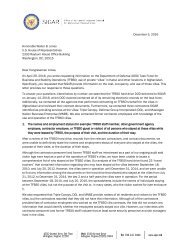SIGAR
2016-04-30qr
2016-04-30qr
You also want an ePaper? Increase the reach of your titles
YUMPU automatically turns print PDFs into web optimized ePapers that Google loves.
<strong>SIGAR</strong> oversight Activities<br />
Afghan Ministry of Defense headquarters building in Kabul, January 7, 2016.<br />
(<strong>SIGAR</strong> photo by Wilhelmina Pierce)<br />
to install a fire-rated glass entry door. An AFCEC official told <strong>SIGAR</strong> that all<br />
three deficiencies have since been corrected.<br />
During six inspection visits to the MOD headquarters building, <strong>SIGAR</strong><br />
examined the roof drainage system, seismic-separation joints, exterior walls<br />
and stairwells, plumbing fixtures and mechanical equipment, auditorium<br />
seats and platform stage, electrical and water systems, windows, doors, and<br />
ceiling panels, as well as fire-suppression pumps, fire alarms, and communications<br />
lines. <strong>SIGAR</strong> found other deficiencies not identified by AFCEC that<br />
could affect the building’s structural integrity during an earthquake or prolonged<br />
periods of rain. These include issues with building separation joints<br />
needed for seismic activity, lateral bracing of equipment needed for seismic<br />
activity, inadequate roof drains to remove storm water, and stairway handrails<br />
that were installed below the required height.<br />
Specifically, <strong>SIGAR</strong> found:<br />
• The headquarters building’s separation joints, needed to counter<br />
seismic activity, were (1) not continuous or aligned vertically from<br />
the foundation up to and through the roof; and (2) were spanned<br />
with non-structural systems, such as drain pipes, on the inside of the<br />
building without the required flexible connections. For example, <strong>SIGAR</strong><br />
found that at least three of the seven separation joints did not provide<br />
complete breaks in the floors, walls, and ceiling that would divide<br />
the building into discrete sections. As a result, it is possible that one<br />
of the building’s seven sections will move more than allowed during<br />
an earthquake.<br />
• Building equipment did not have lateral bracing needed for seismic<br />
activity. The contracts required that building standards be based<br />
on DOD’s Unified Facilities Criteria. Those standards require that<br />
38<br />
Special inspector general I Afghanistan reconstruction




